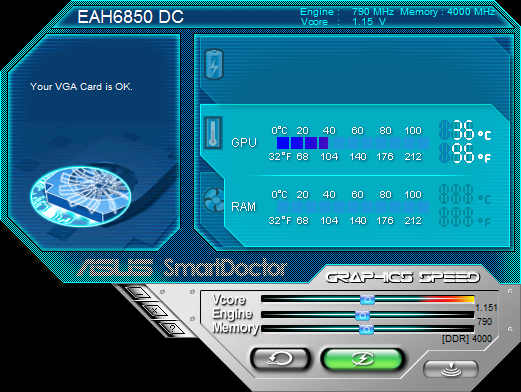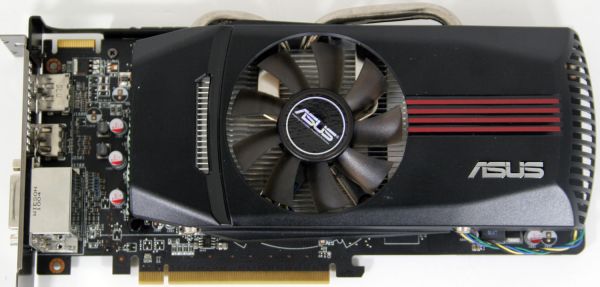AMD Radeon HD 6850 Overclocking Roundup: Asus, XFX, & MSI
by Ryan Smith on November 8, 2010 12:40 AM ESTMeet The Asus EAH6850
Our second card today is Asus’s first Radeon HD 6850, the EAH6850.The EAH6850 is the latest member in Asus’s Voltage Tweak subseries of cards, offering official voltage modification capabilities for overclocking through Asus’s SmartDoctor utility. It’s also the first overclocked card in today’s roundup, featuring a stock speed of 790MHz core and 1000MHz memory, a mere 15MHz over the 6850’s standard clocks. As a result the overclock is a token overclock at best - it’ll edge out stock-clocked cards in testing, but the difference is nothing to write home about.
In terms of design Asus has more or less completely thrown out the 6850 reference design for their own design. Starting with the PCB, Asus has gone with a custom PCB that runs a half-inch longer than the reference PCB, giving the EAH6850 a final length of 9.5”. With this extension Asus has moved the 6pin PCIe power socket to the top of the card, removing the need for additional clearance behind the card and in the process making the power socket much more accessible. Notably there’s a spot for a second power socket, and given the longer length of the card we wouldn’t be surprised if Asus ultimately released a 6870 using this PCB.
Meanwhile the component selection on the card is the usual mix of solid state capacitors and chokes. We haven’t been able to identify the VRM components in use, but we believe Asus is using a different VRM arrangement than on the reference 6850. The card also features a metal spine running down most the length of the card, providing the extra rigidity that a longer card requires and preventing it from significantly flexing.
Attached to the top of the card is the now customary Asus DirectCU cooler, Asus’s highly effective cooler which we have seen on a number of Asus cards in the past. This open-ended cooler uses a pair of aluminum heatpipes attached to a copper baseplate to transfer heat to the card’s aluminum heatsink, which runs roughly 2/3rds the length of the card. Embedded in the middle of the heatsink is the 70mm “dustproof” fan, and a partial shroud keeps airflow directed out the front and the rear of the card. Meanwhile the MOSFETs serving as part of the VRM circuitry have their own heatsink attached through springloaded clips, with airflow coming off of the fan keeping this second heatsink cool.
As is the case with the other partner cards in today’s roundup, Asus has ditched AMD’s 6800 series Eyefinity port configuration in favor of the 5800 series Eyefinity port configuration. This means the card has two DVI ports and the HDMI port along with one full-size DisplayPort, allowing the card to drive up to 5 monitors through a DP hub.

Because this is a Voltage Tweak card, Asus’s software plays an important role here by providing control for the card’s voltage modification capabilities. SmartDoctor has not changed since the last time we’ve seen it, providing a functionally competent but ultimately second-rate overclocking experience, as SmartDoctor lacks meaningful monitoring capabilities. Truth be told, the latest betas of MSI’s Afterburner software are able to program the EAH6850’s VRM controller, meaning there’s no practical reason to use SmartDoctor as the superior Afterburner is available.

As for pack-in items, Asus includes their usual collection for an AMD card: a quick-start manual, driver/utility CD, molex-to-PCIe power adaptor, short CrossFire bridge, a pleather CD binder, and a DVI-to-VGA dongle. Which on that note we had a chance to talk to Asus’s video card product manager last week and asked about the VGA dongle – it turns out that while VGA is largely dead & buried in North America, it’s alive and well in the Asia-Pacific region. Asus is simply packing their cards the same way in all regions, which means they all come with the VGA dongle.
Finally, the EAH6850 comes with Asus’s standard 3 year video card warranty. EAH6850 can be found for around $185, putting it at a $5 premium over AMD’s MSRP.


















93 Comments
View All Comments
Mr Perfect - Monday, November 8, 2010 - link
AT normally tears the cooler off to examine the card, and then dissects the cooler itself too. Neither 6800 article has done this though. It should be an even bigger priority when we're comparing non reference cards that are competing purely on their unique designs. Are these cards on loan? Do they have to be returned in the same condition they where received? If so, I say just ship them back without reviewing them. :PI just came from XBitLabs, where they did a proper teardown of both a stock 6850 and 6870, and that Asus card looks a lot like the stock 6870 board. It has the two top mounted PCIe power connectors, and the VRMs appear to be between the GPU and IO ports. I would not be surprised if it really was a 6870 PCB. Check it out!
khimera2000 - Monday, November 8, 2010 - link
I appreciate the review, it looks alot less of a hot article as the last one, and its clear that a good amount of effert went into this article just by the comments AT left, and the way the article was written.I was also wondering when will the review of the higher end 6xxx card be availabe?
Cali3350 - Monday, November 8, 2010 - link
A lot of Doom and Gloom here about the OC cards. Let me try and tell you, Ryan and Anand, what I think the people want as a majority:1. Never use OC'd cards in a initial review. Ever. You guys, quite frankly, should have known this and the flak you are getting for using it is deserved imo. Nvidia conned you guys into making their cards unfairly better than the competition in the main review article of a major launch and you fell for it. That article will likely get much more readership than any roundup, and is likely to be looked up in higher numbers down the line. You played that one like a PR branch of Nvidia and you made people angry (imo rightly so). Dont ever do this again. Do not review anything but stock clocks in your GTX 580 review tommorow, and dont you dare use a overclocked anything in your upcoming Cayman review either.
2. Always use OC'd cards in your comparisons. This a COMPARISON article of AIB's and the products they are offering. Ofcourse we want to see how a overclocked 460 compares to a overclocked 6850, this is the article where we go over what is out there in the retail market, not what is officially supplied by the creators. This article loses a lot of value without a 460 OC'd in it.
Launch articles = what we are getting from the creators of the product.
Comparison articles = what we are buying in the real world.
I love this site, and I do not think your biased, but I wont defend you over the 68XX review either.
AnandThenMan - Monday, November 8, 2010 - link
I agree with what you are saying here. The problem is, the genie is out of the bottle. Anandtech should not let the 68xx review stand as is, the FTW results should be removed, and all references to it. And if that is not done, then overclocked AMD cards must be included in all future reviews, no exceptions. In fact, Anandtech should accept a hand picked, delivered to their door card from AMD.If neither are done, then I would question all results published here, there is a credibility problem to say the least. You can't start picking and choosing how reviews are done depending on the hardware. That is exactly why policies are in place. Sadly that policy was ignored.
Jamahl - Wednesday, November 10, 2010 - link
This.Ryan Smith and Anand deserve the fallout over this. They brought it on themselves as does any site that shifted their goalposts in the past few weeks.
Dwebtron - Monday, November 8, 2010 - link
I'm super interested in this one, as I'm holding on to mine... but it never appears in the charts?RaptorTek - Monday, November 8, 2010 - link
Its really the immature fanboys that cant handle seeing their company/card lose that make a stink about including the FTW OC cards in the mix. It makes them feel insecure about themselves and their decisions on being a fanboy for which they decided to spend their hard earned money on. When it comes down to it, the more data we have available the better the decisions we can make on what really is the best hardware for the price. Having the FTW 460 1gb in the stock 6850/6870 article was good since it showed what the contending cards possibilities were. Including the FTW 460 1gb in this OC article would of been even more relevant for side by side comparisons. I would hope Anandtech can see that even if some of "the readers" complain about these things, its really for the best in the logical comparison of these cards.
El_Capitan - Monday, November 8, 2010 - link
Indeed. Why would any logical person WANT LESS data?Fanboy: My HD 6850 that I bought for $189.99 is better than a stock GTX 460 1GB you purchased for $239.99, and overclocks higher!
Realist: I bought by GTX 460 1GB for $189.99 and it overclocks to 1015MHz without unlocking the voltage, what are you talking about?
Fanboy: AnandTech doesn't show that, so it's not relevant!
Realist: You're retarded.
Fanboy: You're an Nvidia fanboy!
Realist: I also own a HD 5870 2GB that I bought for $250.
Fanboy: Yeah, right, whatever!
Realist: ...
Fanboy: Stupid fanboys, they think they know everything.
Realist: :Facepalm:
AnandThenMan - Monday, November 8, 2010 - link
You both completely missed the point, and sounded childish and fanboy-ish in the process.jsrivo - Monday, November 8, 2010 - link
From what I've read, the OCed cards are reaching 800-900MHz on average, and claiming that 1015MHz is realistic for most buyers is a bit fanboyish, in my opinion.